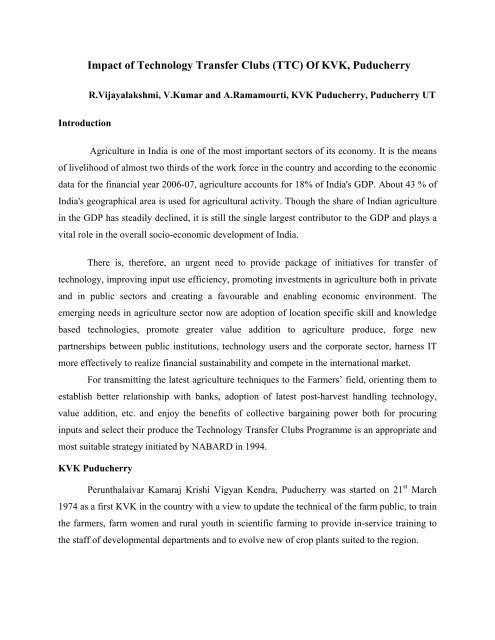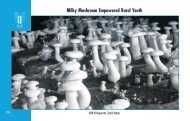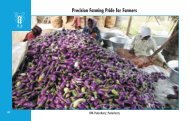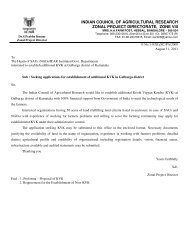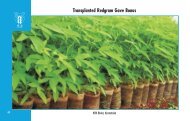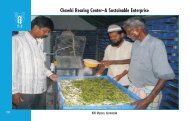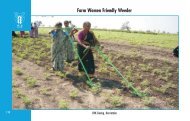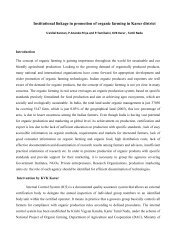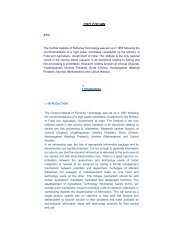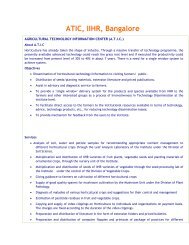Impact of Technology Transfer Clubs (TTC) Of KVK, Puducherry
Impact of Technology Transfer Clubs (TTC) Of KVK, Puducherry
Impact of Technology Transfer Clubs (TTC) Of KVK, Puducherry
You also want an ePaper? Increase the reach of your titles
YUMPU automatically turns print PDFs into web optimized ePapers that Google loves.
<strong>Impact</strong> <strong>of</strong> <strong>Technology</strong> <strong>Transfer</strong> <strong>Clubs</strong> (<strong>TTC</strong>) <strong>Of</strong> <strong>KVK</strong>, <strong>Puducherry</strong>R.Vijayalakshmi, V.Kumar and A.Ramamourti, <strong>KVK</strong> <strong>Puducherry</strong>, <strong>Puducherry</strong> UTIntroductionAgriculture in India is one <strong>of</strong> the most important sectors <strong>of</strong> its economy. It is the means<strong>of</strong> livelihood <strong>of</strong> almost two thirds <strong>of</strong> the work force in the country and according to the economicdata for the financial year 2006-07, agriculture accounts for 18% <strong>of</strong> India's GDP. About 43 % <strong>of</strong>India's geographical area is used for agricultural activity. Though the share <strong>of</strong> Indian agriculturein the GDP has steadily declined, it is still the single largest contributor to the GDP and plays avital role in the overall socio-economic development <strong>of</strong> India.There is, therefore, an urgent need to provide package <strong>of</strong> initiatives for transfer <strong>of</strong>technology, improving input use efficiency, promoting investments in agriculture both in privateand in public sectors and creating a favourable and enabling economic environment. Theemerging needs in agriculture sector now are adoption <strong>of</strong> location specific skill and knowledgebased technologies, promote greater value addition to agriculture produce, forge newpartnerships between public institutions, technology users and the corporate sector, harness ITmore effectively to realize financial sustainability and compete in the international market.For transmitting the latest agriculture techniques to the Farmers’ field, orienting them toestablish better relationship with banks, adoption <strong>of</strong> latest post-harvest handling technology,value addition, etc. and enjoy the benefits <strong>of</strong> collective bargaining power both for procuringinputs and select their produce the <strong>Technology</strong> <strong>Transfer</strong> <strong>Clubs</strong> Programme is an appropriate andmost suitable strategy initiated by NABARD in 1994.<strong>KVK</strong> <strong>Puducherry</strong>Perunthalaivar Kamaraj Krishi Vigyan Kendra, <strong>Puducherry</strong> was started on 21 st March1974 as a first <strong>KVK</strong> in the country with a view to update the technical <strong>of</strong> the farm public, to trainthe farmers, farm women and rural youth in scientific farming to provide in-service training tothe staff <strong>of</strong> developmental departments and to evolve new <strong>of</strong> crop plants suited to the region.
<strong>Technology</strong> <strong>Transfer</strong> <strong>Clubs</strong>To propagate the locally appropriate technology on farms that will result in enhancingproduction and productivity <strong>of</strong> agriculture and allied activities, agro processing etc., along withthe adoption <strong>of</strong> principles <strong>of</strong> development through credit, it was decided to set up <strong>Technology</strong><strong>Transfer</strong> <strong>Clubs</strong> with close association <strong>of</strong> <strong>KVK</strong>s.Activities<strong>Technology</strong> <strong>Transfer</strong> will be the major activity <strong>of</strong> the Club. However, in order to generateadequate interest <strong>of</strong> the farmers and other village people in the activities <strong>of</strong> the club, it may benecessary to focus on various other activities also, which may be in the nature <strong>of</strong> provision <strong>of</strong>minimum basis needs, infrastructure development, environment protection, social activities,human and health, economic activities, etc. This will also ensure integrated development <strong>of</strong> thevillage with people’s participation. The club should organize a meet and match programme inone <strong>of</strong> the villages wherein the common needs <strong>of</strong> people in individual village as also thecommon needs <strong>of</strong> all villages put together in the area <strong>of</strong> the club may be identified and an actionplan for at least 3 ensuing cropping seasons should be prepared on fortnightly/monthly basis.Normally, month-wise programme may be chalked out, but in some months the programme mayhave to be chalked out for meetings <strong>of</strong> club volunteers and villagers on fortnightly basis.The <strong>KVK</strong>s will undertake an extensive survey <strong>of</strong> resources with the people in eachvillage <strong>of</strong> the club for which appropriate forms may be designed. This survey will be got donethrough the volunteers after adequate training to them. Based on such surveys, the resourcemapping <strong>of</strong> the villages may be done by <strong>KVK</strong>’s scientists / <strong>of</strong>ficial, who may help them inidentification <strong>of</strong> technology requirements in the club area. Extension soil testing may also beundertaken as an essential activity by <strong>KVK</strong>s scientist through club volunteers for providing farmguidance to each <strong>of</strong> the farmers in the club area. Based on information so collected, thebenchmark information <strong>of</strong> the clubs may also be maintained. All these activities will be donethrough the volunteers <strong>of</strong> concerned clubs.
Based on resource mapping, the village development plan may be prepared by the clubunder the guidance <strong>of</strong> <strong>KVK</strong>s. Such a plan should take into consideration the local peoplesaspirations and ensure their involvement in the development process. The clubs may not be in aposition to undertake all developmental activities identified in the village development planimmediately. Therefore, by mutual discussions, the volunteers may priorities the items <strong>of</strong>development – initiatives for themselves and a time bound programme for these initiatives maybe chalked out.Various State agencies as also NGOs are undertaking several developmental activities atpresent. The club may take advantage <strong>of</strong> these programmes for achieving their own action plans;for this purpose, the clubs may undertake an exercise <strong>of</strong> matching their needs with the supportavailable from various Government Departments under their schemes. The clubs may approachconcerned Departments for such a support in an appropriate manner for which <strong>KVK</strong> andNABARD’s DDM may provide signposting assistance to the club volunteers.The clubs may be required to organize field demonstration, meets, workshops, etc., forvarious activities <strong>of</strong> <strong>Technology</strong> <strong>Transfer</strong> before the cropping season with the support <strong>of</strong> <strong>KVK</strong>sand other State Departments.The clubs may also undertake the activities for creation <strong>of</strong> awareness against naturaldisaster amongst the village people. In the eventuality <strong>of</strong> natural disaster, the clubs mayundertake activities for appropriate <strong>Technology</strong> <strong>Transfer</strong> as also post disaster management,including insurance claims.In order to sustain the interest <strong>of</strong> volunteers, the clubs may undertake various activitiesthat may provide the social recognition and social eastern to the clubs. <strong>KVK</strong>s and NABARD’sDDM may be helpful in this regard.The farmer’s clubs may also undertake maintenance <strong>of</strong> a small library containingbrochures and farmer-friendly books on various farm technologies. Information Brochuresbrought out by ICAR / <strong>KVK</strong>s and NABARD may also be provided for club libraries. Whereverthe Farmers <strong>Clubs</strong> have access to the computer system <strong>of</strong> Panchayats and other bodies, they mayalso be supplied with floppies or CDs containing information on up-to-date farm technologies.
<strong>KVK</strong>s may undertake development <strong>of</strong> such digital information on farm technology with thesupport <strong>of</strong> various ICAR institutions.<strong>Technology</strong> <strong>Transfer</strong> <strong>Clubs</strong> in <strong>Puducherry</strong>Nine <strong>Technology</strong> <strong>Transfer</strong> <strong>Clubs</strong> were sanctioned by NABARD and inaugurated on18.10.04 by the Hon’ble Chief Minister in <strong>KVK</strong>. Each <strong>Technology</strong> <strong>Transfer</strong> <strong>Clubs</strong> covers acluster <strong>of</strong> 2-3 nearby villages. NABARD provided financial support for administrative expenses@ Rs. 3000/- per club/year and maintenance expenses for clubs for 5 years @ Rs.3000/club/year.Conducted base level orientation Training programmes in each <strong>Technology</strong> <strong>Transfer</strong>Club's as per the guidelines <strong>of</strong> NABARD. In order to assess the working <strong>of</strong> the T.T.C and to getfeed back, structural review meetings were held on the 25 th <strong>of</strong> every month by PK<strong>KVK</strong>. In thesemeeting, apart from review <strong>of</strong> the performance, the accounts were scrutinized necessaryrectifications suggested and the plan for future activities were chalked out.Training programmes on “Innovative <strong>Technology</strong> for increasing productivity inAgriculture” were organized in this Kendra under capacitybuilding for adoption <strong>of</strong> <strong>Technology</strong> programme <strong>of</strong> theNABARD, <strong>Puducherry</strong>.Perunthalaivar Kamaraj Krishi Vigyan Kendra,<strong>Puducherry</strong> organized a four day exposure visit for themembers <strong>of</strong> T.T.Cs with the financial support <strong>of</strong> NABARDfrom 14.2.06 to 17.2.06.Special need based skill development trainings were organized every month in <strong>KVK</strong> onagriculture and allied subjects with the financial assistance <strong>of</strong> NABARD.Significance <strong>of</strong> the <strong>KVK</strong>As per the mandate <strong>of</strong> ICAR, this Kendra conducts training programmes to Farmers,Farm women, Rural Youth and the Extension Functionaries on Agriculture and allied fields likeAnimal Husbandry, Fisheries, Home Science etc.. This <strong>KVK</strong> also conducts On Farm Testingand Front Line Demonstration on various fields apart from undertaking other extension
activities like Farm Advisory Services, publishing News letter, hosting Website, organizingFarm Science Club, <strong>Technology</strong> <strong>Transfer</strong> <strong>Clubs</strong> and Self Help Groups. Kendra also undertakesactivities under All India Coordinating Rice Improvement Projects, Vocational AgriculturalCourse, and production <strong>of</strong> tissue cultured plants from Tissue Culture Laboratory, Bio -agentsproduction through Bio Control Laboratory, vegetable & ornamental seedlings from Hi-TechHorticultural nursery, Paddy Seed Production and Horti-Care scheme.Project PeriodInitially, it is aimed that <strong>KVK</strong>s may set up the clubs during the years 2003-04 and 2004-05. These clubs will be supported by NABARD for a period <strong>of</strong> 5 years. In such a manner, thecollaboration with <strong>KVK</strong>s under this Project will be for the period beginning 2003-04 to 2008-09,unless, a decision is taken to continue opening <strong>of</strong> clubs during the years beyond March 2005 andcontinue supporting them for subsequent 5 years.<strong>Impact</strong> analysisThe present investigation was undertaken by the Home Science Scientist to study theeffectiveness <strong>of</strong> <strong>Technology</strong> <strong>Transfer</strong> <strong>Clubs</strong> <strong>of</strong> <strong>KVK</strong> in Pondicherry region on the empowerment<strong>of</strong> women. This would be <strong>of</strong> great help to the implementing agencies to bring necessaryimprovements in the <strong>Technology</strong> <strong>Transfer</strong> <strong>Clubs</strong> for attaining the overall empowerment <strong>of</strong> farmwomen.ObjectivesPrimarily the objective is to analyse the socio-economic characteristic <strong>of</strong> the <strong>Technology</strong><strong>Transfer</strong> <strong>Clubs</strong> in particular reference to Women empowerment.Secondly to study the nature <strong>of</strong> the <strong>Technology</strong> <strong>Transfer</strong> <strong>Clubs</strong> that are beingimplemented and assess its effectiveness and contribution to the development <strong>of</strong> the skills<strong>of</strong> the rural women folk for the past five years.
Thirdly, the study aims at assessing the relative differences on the performance <strong>of</strong><strong>Technology</strong> <strong>Transfer</strong> <strong>Clubs</strong> and their effect on the empowerment <strong>of</strong> the women, inrelation to economic and social point <strong>of</strong> view.MethodologySample SelectionThis study is the micro level investigation <strong>of</strong> examining the impact <strong>of</strong> <strong>KVK</strong> <strong>Technology</strong><strong>Transfer</strong> <strong>Clubs</strong> over the period <strong>of</strong> the past five years. The selection <strong>of</strong> sample is confined to onlythe members <strong>of</strong> <strong>Technology</strong> <strong>Transfer</strong> cubs <strong>of</strong> <strong>KVK</strong> in Pondicherry region. The total number <strong>of</strong>respondents from <strong>TTC</strong>s fixed was 180.
Data collectionThe data required for the study was collected, administering a detailed survey schedulethrough personal interview with the respondents. Interview schedule is in Annexure.Data processing and AnalysisAfter the field survey was over, the entire survey schedules were thoroughly scrutinized.Then all the data collected were coded, and processed so as to have the required tables and theresults <strong>of</strong> statistical pro<strong>of</strong>. Some statistical tools and techniques like percentage analysis, meanand graphical representations have been applied to examine the statistical relationship betweenthe role <strong>of</strong> <strong>Technology</strong> <strong>Transfer</strong> <strong>Clubs</strong> and Women’s empowerment.Major resultsTable 1: Marital status <strong>of</strong> the T.T.C beneficiariesS.T.T.C BeneficiariesMarital StatusNoNumberPercentage1. Married 147 822. Unmarried 24 133. Widow 9 5TOTAL 180 100The table 1 gives the details on the marital status <strong>of</strong> the beneficiaries <strong>of</strong> T.T.Cs. It couldbe seen from the study that 82 per cent <strong>of</strong> the married women benefited in the club. The studyalso reveals that only 13 per cent and 5 per cent <strong>of</strong> unmarried women and widows respectivelyhave benefited in the club activities.Table 2: Literacy status <strong>of</strong> the T.T.C beneficiariesS.T.T.C BeneficiariesMarital StatusNoNumberPercentage1. Illiterate 4 22. Primary 41 233. Secondary 90 504. Higher Secondary 31 175. Collegiate education 14 8TOTAL 180 100From table 2, it is clear that the educational status <strong>of</strong> the beneficiaries <strong>of</strong> the selectedsamples. It could be seen from the above table that 50 per cent <strong>of</strong> the beneficiaries had secondary
level <strong>of</strong> education. Only 23 per cent and 8 per cent beneficiaries had primary collegiate educationrespectively.Table 3: Occupational status <strong>of</strong> the T.T.C beneficiariesS.NoMarital StatusT.T.C BeneficiariesNumberPercentage1. Cooli 40 222. Business 46 263. Private company 13 74. Farmer 81 45TOTAL 180 100The results in table 3 reveals that 45 per cent <strong>of</strong> the beneficiaries were farmers and 26 percent <strong>of</strong> the beneficiaries were doing their own business.Table 4: Average Monthly Income level <strong>of</strong> the beneficiariesS.NoIncome in Rs.T.T.C BeneficiariesNumberPercentage1. below 1000 38 212. 1000 – 2000 95 533. 2000 – 3000 26 144. 3000 – 4000 11 65. 4000 & above 10 6TOTAL 180 100The gradual increase in the income <strong>of</strong> the household <strong>of</strong> the T.T.C beneficiaries with theintervention <strong>of</strong> <strong>KVK</strong> is obvious from the above table. It is interesting to note that there is adecrease in the households <strong>of</strong> T.T.C beneficiaries with income slab < Rs.1000 over a period <strong>of</strong>five years. This indicates that they have moved to the higher income slab > Rs.1000. This impactis because <strong>of</strong> the continuous support <strong>of</strong> <strong>KVK</strong> by imparting various training programmes andrendering advisory services. It is graphically shown in figure 1.Table 5: Skill development trainings undergone by the T.T.C beneficiaries in variousorganisationsS.NoOrganisation Number Percentage1. Krishi Vigyan Kendra 147 822. Women Development Corporation 13 73. District Rural Development 13 7
Agency4. M.S. Swaminathan Research 5 35. Department <strong>of</strong> Animal Husbandry 2 1TOTAL 180 100From the above table it is clear that, 82 per cent <strong>of</strong> the beneficiary’s undergone training atKrishi Vigyan Kendra, <strong>Puducherry</strong>. Only 7 per cent and 8 per cent <strong>of</strong> the beneficiary’sundergone training at Women Development Corporation and District Rural DevelopmentAgency respectively.Table 6: Organization wise details <strong>of</strong> skill development training undergone by the T.T.Cbeneficiaries over a period <strong>of</strong> five years<strong>KVK</strong> WDC DRDA MSSRFS.No Period Percen No. Percen No. Percen No. PercenNo.tagetagetagetage1. 2004 18 10 1 7 3 23 - -2. 2005 27 15 2 15 1 7 1 203. 2006 36 20 3 23 2 15 2 404. 2007 45 25 3 23 3 23 1 205. 2008 54 30 4 32 4 32 1 20TOTAL 180 100 13 100 13 100 5 100The table 6 indicates the details <strong>of</strong> the skill development training undergone by the T.T.Cbeneficiaries in various organizations over a period <strong>of</strong> five years. The considerable increase inthe entrepreneurship development programmes <strong>of</strong>fered by Krishi Vigyan Kendra is mainly dueto the interest shown by the members <strong>of</strong> T.T.Cs.Table 7: Training undertaken by the members <strong>of</strong> the <strong>Technology</strong> <strong>Transfer</strong> <strong>Clubs</strong>S.NoTrainingTotal N - 180Number Percentage1. Entrepreneurship Development programme 180 1002. All Crop production techniques 180 1003. Nutrition and Health education 180 1004. Dairy management 180 1005. Poultry 180 1006. Goat rearing 180 1007. Pisciculture 180 1008. Child rearing practices 180 1009. Home management 180 10010. Formation and maintenance <strong>of</strong> SHGs 180 100
Table 7 reveals the fact that various need based training programmes were <strong>of</strong>fered by<strong>KVK</strong> over a period <strong>of</strong> five years to the members and other beneficiaries.Table<strong>of</strong>microenterprises started by the T.T.C beneficiaries over a period <strong>of</strong> five years8: DetailsS. No PeriodTotal N-56BeneficiariesNumber Percentage1. 2004 7 132. 2005 9 163. 2006 12 214. 2007 13 235. 2008 15 27TOTAL 56 100From the above table it is clear that there was gradual increase in the percentage <strong>of</strong> microenterprises started by the T.T.C beneficiaries over a period <strong>of</strong> five years. Details are shown inFig. 1Fig 1 Details <strong>of</strong> microenterprises started by the T.T.C beneficiaries over a period <strong>of</strong> fiveyears.
Table 9: Details <strong>of</strong> Amount invested by the T.T.C beneficiaries for startingmicroenterprisesS.NoAmount in Rs.Total N--56BeneficiariesNumber Percentage1. Below 1000 16 292. 1000 – 2000 15 273. 2000 – 3000 3 54. 3000 – 4000 4 75. 4000 and above 18 32TOTAL 56 100The above table reveals that 29 per cent <strong>of</strong> the beneficiaries invested only belowRs.1000/- for starting microenterprises whereas 32 per cent <strong>of</strong> the beneficiaries invested aboveRs.4000/-. The rest <strong>of</strong> the beneficiaries invested amount between the ranges <strong>of</strong> the Rs. 1000 and
Rs. 4000/-.It also clearly reveals that the beneficiaries needs financial assistance for expandingtheir self employment units.Table 10: Production details <strong>of</strong> T.T.C beneficiaries through microenterprisesS.NoItemsTotal N-56Qty/mth Number Percentage1. Cleaning powder 80 kg 6 112. Soap Oil 20 lt 9 163. Sambrani bathi 10 kg 4 74. Phenyl 50 lt 13 235. Pickle 15 kg 4 76. Papad 20 kg 2 3.57. Snacks 25 kg 2 3.58. Catering work 30 kg 2 3.59. Fruit squash 35 lt 4 710. Fruit Jam 10 kg 4 711. Floriculture 20 kg 2 3.512. Poultry 90 kg 2 3.513. Masala powder 26 kg 2 3.5TOTAL 56 100The above table shows the production details <strong>of</strong> the T.T.C beneficiaries. Details areshown in Fig 2.Fig 2: Production details <strong>of</strong> T.T.C beneficiaries through microenterprises.
Table 11: Average Monthly Pr<strong>of</strong>it details <strong>of</strong> the microenterprises carried out by the T.T.CbeneficiariesTotal N-56S.Amount in Rs.BeneficiariesNoNumber Percentage1. Below 1000 9 162. 1000 – 2000 11 203. 2000 – 3000 27 484. 3000 – 4000 4 75. 4000 and above 5 9TOTAL 56 100From table 11, it is interesting to note that 16 per cent and 20 per cent <strong>of</strong> the beneficiariesobtained average monthly pr<strong>of</strong>ited below Rs. 1000 and Rs. 2000 respectively. It could also beseen from the above table 48 per cent <strong>of</strong> the beneficiaries obtained pr<strong>of</strong>it in the range betweenRs. 2000/- Rs. 3000/- and 9 per cent <strong>of</strong> the beneficiaries obtained pr<strong>of</strong>it in the range <strong>of</strong> Rs. 4000and above. Details are shown in Fig 3.Fig 3: Average Monthly Pr<strong>of</strong>it details <strong>of</strong> the microenterprises carried out by the T.T.Cbeneficiaries
Table 12: Assets created by the T.T.C beneficiaries through microenterprisesS.NoAmount in Rs.Total N-42BeneficiariesHome appliances 8 19Vehicles 7 17Education for Children 10 24Part <strong>of</strong> the House construction (Small size) 1 2Jewels 2 5Loan repayment 4 9Expanded business 10 24TOTAL 42 100In the above table, an analysis is made with regard to the assets created by the T.T.Cbeneficiaries through microenterprises. It could be noted that 19 percent and 17 per cent <strong>of</strong> thebeneficiaries created assets in the form <strong>of</strong> Home appliances and vehicles respectively. The rest <strong>of</strong>them spent amount for loan repayment (9 percent), children’s education (24 percent), houseconstruction (2 percent), expanding business (24 percent) and jewels (5 percent). Details areshown in Fig 4.Fig 4: Assets created by the T.T.C beneficiaries through microenterprises
Table 13: Problem faced by the T.T.C beneficiaries during marketing the productsS.NoProblemsBeneficiariesNumber Percentage1. Fixed marketing place is not available 52 482. Transport charge is high 24 223. Family support is less 15 144. Advertisement is lacking 18 16TOTAL 109 100Table 13 indicates that the study is with regard to the problems faced by the T.T.Cbeneficiaries during marketing the products produced by them. It is seen that 48 per cent <strong>of</strong> thebeneficiaries expressed that they did not have any fixed marketing place to sell their products. 22percent <strong>of</strong> the beneficiaries expressed that the transport charge is high, 14 percent <strong>of</strong> themrevealed that the family support is less and 16 percent expressed that advertisement is lacking fortheir quality products. Details are shown in Fig 5.Fig 5: Problem faced by the T.T.C beneficiaries during marketing the products produced bythem.Table 14: Training given to villagers by the T.T.C beneficiariesS.NoTraining TitleVillage membersNumber Percentage1. Entrepreneurship Development programme 112 72. Crop production techniques 942 61
3. Nutrition and Health Education 310 204. Dairy management 120 85. Goat rearing 41 36. Poultry 15 1TOTAL 1540 100From the table 14, it is observed that the members <strong>of</strong> T.T.C who had undergone trainingat Krishi Vigyan Kendra disseminated technologies to the villagers (1540 nos.) through varioustraining programmes.Table 15: Number <strong>of</strong> villagers started microenterprises under the guidance <strong>of</strong> T.T.CbeneficiariesS.NoMicroenterprisesVillagersNumber Percentage1. Preparation <strong>of</strong> phenyl, soap oil and cleaning powder 17 612. Pickle, Jam and Squash making 3 113. Papad making 2 74. Dairy 6 21TOTAL 28 100It could be seen with the pride from the above table that the impact <strong>of</strong> T.T.C training isgood. Regarding entrepreneurship development, the skill <strong>of</strong> preparation <strong>of</strong> phenyl, soap oil andcleaning powder, pickle, jam, squash making, papad making and dairy has been acquired by61%, 11%, 7% and 21% <strong>of</strong> the T.T.C beneficiaries respectively over a period <strong>of</strong> five years.Details are shown in Fig 6.Fig 6: Number <strong>of</strong> villagers started microenterprises under the guidance <strong>of</strong> T.T.Cbeneficiaries
Table 16: Linkages developed by the T.T.C beneficiaries with other organizationS.No Organisation Nature <strong>of</strong> linkageTotal N-579BeneficiariesNumber Percentage1. Women DevelopmentTraining 80 14Corporation2. DRDA Training 29 53. M.S. Swaminathan Research Training 5 1Foundation4. Department <strong>of</strong> Agriculture Supply <strong>of</strong> vegetable seeds 45 85. Department <strong>of</strong> Animal Husbandry Training 55 96. Women and Child Development Seminar 100 17Department7. Food and Nutrient Board Training 70 128. Health Department Health camp 120 219. Forestry Supply <strong>of</strong> saplings 75 13TOTAL 579 100The above table shows the linkages developed by the T.T.C beneficiaries with otherorganization. It could be seen that the intervention <strong>of</strong> Krishi Vigyan Kendra and its constantmotivation shows good impact <strong>of</strong> <strong>TTC</strong>s in having linkages with other organizations.Table 17: No <strong>of</strong> beneficiaries participated in Meet with Expert programme organized bythe T.T.CsS.NoProgrammeTotal N-2890Qty inBeneficiariesNos.Number Percentage1. 2004-2005 18 468 162. 2005-2006 18 550 193. 2006-2007 18 576 204. 2007-2008 18 612 215. 2008-2009 18 684 24TOTAL 90 2890 100Table 17 gives the details <strong>of</strong> villagers benefited in Meet with expert programmeorganized by the <strong>TTC</strong>s in respect villages.
Table 18: Benefits gained by the T.T.C beneficiaries through meet with expert programmeS.NoBenefitsTotal N-1800BeneficiariesNumber Percentage1. Entrepreneurship Development 500 282. Crop management 1100 613. Floriculture 29 24. Dairy Management 75 45. Goat rearing 40 26. Poultry rearing 34 27. Pisciculture 22 1TOTAL 1800 100The above table reveals the fact that the benefits gained by the T.T.C beneficiariesthrough meet with expert programme. The increase in the beneficiaries <strong>of</strong> <strong>TTC</strong>s with theintervention <strong>of</strong> Krishi Vigyan Kendra is obvious from the above table.Table 19: Other Services rendered to the villagers by the T.T.C clubsS.NoServiceTotal N-9Number Percentage1. Village road cleaning 9 1002. Arrangements made for water and electricity facilities 7 783. Plantation <strong>of</strong> Tree saplings in Public places 9 1004. Helped to receive old age and widow pension 9 1005. Started tuition centre for week students 1 116. taken initiative for bus facilities 1 117. Conducted health camps 4 44From the above table it is clear that the T.T.C members extended good social services tothe public with the guidance <strong>of</strong> Krishi Vigyan Kendra and linkages with other organizations.Table 20: Number <strong>of</strong> Self Help Groups started by the <strong>Technology</strong> <strong>Transfer</strong> <strong>Clubs</strong> underthe guidance <strong>of</strong> <strong>KVK</strong>S.NoYearTotal N-53BeneficiariesNumber Percentage1. 2004-2005 8 152. 2005-2006 10 193. 2006-2007 11 20
4. 2007-2008 12 235. 2008-2009 12 23TOTAL 53 100It could be seen from the Table 20 that with the guidance <strong>of</strong> Krishi Vigyan Kendra,Leaders <strong>of</strong> <strong>Technology</strong> <strong>Transfer</strong> <strong>Clubs</strong> had formed 53 Self Help Groups. All the groups werefunctioning well with the motivation <strong>of</strong> T.T.CsTable 21: Savings amount <strong>of</strong> Self Help Groups which was started by the <strong>Technology</strong><strong>Transfer</strong> <strong>Clubs</strong>S.No Amount in Rs.Total N-53BeneficiariesNumberPercentage1. Upto – 50,000 24 452. 50,000 – 1,00,000 11 213. 1,00,000 – 1,50,000 10 194. 1,50,000 – 2,00,000 8 15TOTAL 53 100From table it is evident that the savings patterns <strong>of</strong> Self Help Groups are analysed. Itcould be seen that the T.T.Cs have motivated the Self Help Groups in cultivating thrift habitamong the beneficiaries. Regarding savings 45 per cent <strong>of</strong> the SHGs had the savings amountupto Rs. 50000/- whereas 21 per cent <strong>of</strong> the SHGs had the savings amount from Rs. 50,000/- toRs. 100000/-. The rest <strong>of</strong> the groups had more than Rs. 100000/- savings amount.Table 22: Purpose <strong>of</strong> loan availed through bank by the villagers with the help <strong>of</strong> T.T.CmembersTotal N-160S.PurposeBeneficiariesNoNumber Percentage1. For starting microenterprises 28 172. For house building construction 11 73. For crop production 68 434. For poultry rearing 5 35. For dairy 12 76. For expanding existing business 16 107. For children’s education 12 8TOTAL 160 100It is interesting to note from the above statistics that the purpose <strong>of</strong> loan availed throughbank by the villagers with the help <strong>of</strong> T.T.C was useful for starting microenterprises, house
uilding construction, crop production, poultry rearing, dairy, expanding existing business andchildren’s education.Table 23: Amount <strong>of</strong> loan availed by the villagers from the bank through T.T.C membersLoan availed by the Repayed loan by the Loan dueS.No Amount in Rs. BeneficiariesbeneficiariesNumber Percentage Number Percentage Number Percentage1. Upto –10000 24 24 24 18 - -2. 10000 – 20000 49 49 46 34 3 753. 20000 – 30000 26 26 26 20 - -4. 30000 – 40000 10 10 10 8 - -5. 40000 – 50000 5 5 4 3 1 256. 50000 and above 23 23 23 17 - -TOTAL 137 100 133 100 4 100In the above table an analysis is made in depth about the amount <strong>of</strong> loan availed by thevillagers from the bank, loan repayed by the beneficiaries and the beneficiaries loan due in thebank. There was a remarkable loan recovery by the bank i.e. 97% and only 3% was loan due inthe bank. This impact was possible mainly by the <strong>TTC</strong>s which stressed the importance <strong>of</strong> loanrepayment and proper utilization <strong>of</strong> the bank.Table 24: Other benefits obtained by the members <strong>of</strong> <strong>Technology</strong> <strong>Transfer</strong> <strong>Clubs</strong> membersthrough <strong>KVK</strong>.S.NoBenefitsTotal N – 180Number Percentage1. Skill Development training 180 1002. All crop production techniques 180 1003. Linkages with other organizations 180 1004. Economic empowerment especially to the women 180 1005. Social development 180 100The above table reveals that all the members in all the nine T.T.Cs obtained the benefits <strong>of</strong> skilldevelopment training, crop production techniques, linkages with other organizations, economicand social empowerment.
them. Among them, 28 villagers started microenterprises under the guidance <strong>of</strong> <strong>Technology</strong><strong>Transfer</strong> <strong>Clubs</strong> members.As far as the problem faced by the beneficiaries, 48 per cent <strong>of</strong> them expressed that theydid not have any fixed marketing place to sell their products whereas others expressed that thetransport charge was high, family support was less and lack <strong>of</strong> advertisement for their products.<strong>TTC</strong>s have good linkage with organizations and banks. Apart from transferring thetechnologies they are also rendering social services to the needy people in the village. Maininference <strong>of</strong> the study is farmers to farmers approach are one <strong>of</strong> the best methods for transferringthe technology.***


